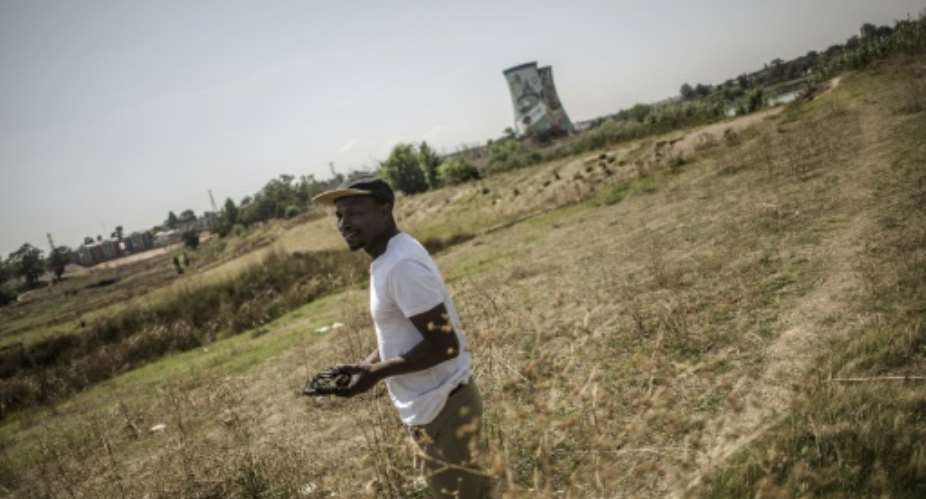Soweto (South Africa) (AFP) - On land that is both a marshy field and a rubbish dump in the township of Soweto, artist Mzi Gojo is looking for a special material to use in his latest work -- cow dung.
"The good thing about summer is that the cow dung is very green and it stays very green on my canvas," he explains.
Gojo is a member of Ubuhle Bobuntu ("beauty of humanity" in Zulu), a group of artists who use recycled materials and experimental techniques to express their own lives in modern South Africa.
The 12 artists are all from Soweto, the former heartland of the violent struggle against apartheid that has now developed into a sprawling town of brick houses and tin-roofed shanks outside Johannesburg.
Gojo, 33, carefully mixes the dung in water -- and adds a little bit of glue -- to achieve the variety of colours and textures needed to produce his mysterious, elegant abstract paintings.
As well as a normal brush, he uses a broken comb, a blade or a piece of plastic grid.
"Cow dung is like a soccer ball. I can control it," he told AFP, wearing an immaculate white shirt and brown chinos on his search through wasteland and stagnant water for exactly the right droppings.
"Winter cow dung makes a nice brown (colour). Calf dung is yellowish because they only drink milk, but it is so hard to get it here.
"I was using this material when I was young. I used to clean the house, and we used dung to make huts. It reminds me of the good times," said Gojo, whose paintings sell for between 5,000 and 50,000 rand ($370 and $3,700).
- 'An alternative way' -
Every artist in Ubuhle Bobuntu has their own technique and recycles whatever they can best exploit for their work: plastic bottle caps, burnt matches and even old bread or human hair.
"There is no art shop in Soweto. We don't have the money. So we had to come up with an alternative way," said Lehlohonolo Mkhasibe, one of the group's founding members.
"We wanted to create a new language, away from the conventional techniques created by the old masters," he said, dressed in a black beret and wearing circular John Lennon-style glasses.
"I was so stressed (after I left school). It is so hard to find linocard. I could not buy any. I had to think outside of the box."
Mkhasibe, who uses his garage as a studio, spent months developing a technique in which he stacks strips of old car tyres together to create a canvas and then cuts into the material to create a black and white image.
It is a method that earned a commission from Austrian energy drinks company Red Bull.
For Victor Mofokeng, bread can be transformed into the perfect means of artistic expression by moulding it or toasting it, and the stale loaves thrown away by supermarkets produce a vivid green.
One of his paintings uses a stunning spectrum of subtle colours to depict youngsters who brandish banners reading "No work, No food".
The intriguing techniques and production of Ubuhle Bobuntu have attracted increasing attention since it launched in 2011, with exhibitions already held in Soweto and at the "Museum Africa" in Johannesburg.
This year, the group's best-known artist Pauline Mazibuko, who works with recycled magazines to make colourful collages, exhibited her work in Santa Fe, New Mexico.
For Charles Nkosi, the enthusiastic head of fine arts at the Funda art college school in Soweto, the group represents an approach that says much about how people live today.
"They are reinventing the world and beautifying it with what people dismiss," he said.





 Former Kotoko Player George Asare elected SRC President at PUG Law Faculty
Former Kotoko Player George Asare elected SRC President at PUG Law Faculty
 2024 elections: Consider ‘dumsor’ when casting your votes; NPP deserves less — P...
2024 elections: Consider ‘dumsor’ when casting your votes; NPP deserves less — P...
 You have no grounds to call Mahama incompetent; you’ve failed — Prof. Marfo blas...
You have no grounds to call Mahama incompetent; you’ve failed — Prof. Marfo blas...
 2024 elections: NPP creates better policies for people like us; we’ll vote for B...
2024 elections: NPP creates better policies for people like us; we’ll vote for B...
 Don’t exchange your life for wealth; a sparkle of fire can be your end — Gender ...
Don’t exchange your life for wealth; a sparkle of fire can be your end — Gender ...
 Ghana’s newly installed Poland train reportedly involved in accident while on a ...
Ghana’s newly installed Poland train reportedly involved in accident while on a ...
 Chieftaincy disputes: Government imposes 4pm to 7am curfew on Sampa township
Chieftaincy disputes: Government imposes 4pm to 7am curfew on Sampa township
 Franklin Cudjoe fumes at unaccountable wasteful executive living large at the ex...
Franklin Cudjoe fumes at unaccountable wasteful executive living large at the ex...
 I'll 'stoop too low' for votes; I'm never moved by your propaganda — Oquaye Jnr ...
I'll 'stoop too low' for votes; I'm never moved by your propaganda — Oquaye Jnr ...
 Kumasi Thermal Plant commissioning: I pray God opens the eyes of leaders who don...
Kumasi Thermal Plant commissioning: I pray God opens the eyes of leaders who don...
